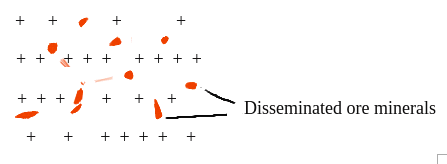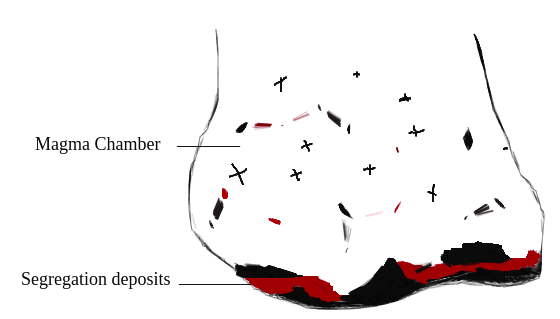Ore forming processes
Ore forming processes
An ore formed can be syngenetic or epigenetic.
Syngenetic ores deposits form with the formation of host rock or say, with the deposition of sediments. BIFs are the good example of syngenetic ore.
Epigenetic ores are just opposite, means they form after the formation of host rocks. Examples are supergene and hydrothermal ore deposits.
Genetic classification of ore forming processes
Genetic classification divides ore forming processes into 8 following types
This process involves formation of deposits during cooling and crystallization of magma. These deposits have close relationship with plutonic igneous rocks. These are of two types, viz. early magmatic and late magmatic.
- Magmatic
- Hydrothermal
- Supergene
- Residual
- Mechanical
- Sedimentation
- Evaporation
- Sublimation
Magmatic processes
This process involves formation of deposits during cooling and crystallization of magma. These deposits have close relationship with plutonic igneous rocks. These are of two types, viz. early magmatic and late magmatic.
- Early Magmatic Deposits
These deposits form in early stages of magma. The ore mineral crystallizes and occurs with high temperature rocks. These can be subdivided into
1. Disseminated deposits
During the crystallization of magma in deep seated conditions, granular igneous rocks form in which ore minerals occurs as disseminated crystals. These deposits can be found in stocks and dikes.

Eg : Diamonds in Panna, Madhya Pradesh.
2. Segregation deposits
When the ore minerals crystallizes in the early stages of magma, they settle down due to gravity and form parallel bands and lenticular shape deposits. These deposits occur interlayer with harzburgite, dunite and gabbro.

Eg. Chromite deposits in ultrabasic rocks.
- Late magmatic deposits
These deposits form in the late stages of crystallization. They are subdivided into 4 types
1. Residual liquid Segregation
When basic magma goes under segregation, the residual magma becomes enriched in Iron and Titanium. This residual magma segregates with ore minerals in the parent mass. These deposits form parallel bands within mafic igneous rocks.
Eg. Magnetite
2. Residual liquid injection
Simply, when the residual magma injected into the country rock, these type of deposits are form. These deposits occurs in dykes and veins.
Eg. Magnetite and Ilmenite.
3. Liquid Immiscibility
Two well known immiscible magma types are sulphides and silicate magma. As the magma cools down, sulphide magma separates out of silicate magma. The minerals like Copper and Nickle which have high affinity towards sulphides also separated out in this process and go with sulphides. These deposits are called Cu-Ni sulphide deposits. These are commonly found at the bottom of bodies.
Hydrothermal Process
Simply, these processes involves the formation of deposits by fluid left during later stages of magma cooling. This fluid phase hot watery solution containing minerals. The source of water to the magma are
- Seawater
- Juvenile water
- connate water
Metals which were originally present in magma, concentrate in this fluid phase.
This hydrothermal solution moves through cracks and fractures in the country rock deposit the dissolved minerals there. It can deposit these minerals by 2 processes, Cavity filling and Replacement.
- Cavity filling
In this process, minerals only precipitates in the openings of surrounding rocks and no replacement involves with the surrounding rocks. This process occurs at low temperature conditions.
The characteristic features of cavity filling deposits are
Crustification : The precipitating mineral first line the wall of cavity. The crystals grow then inwards and points at the centre.
Comb structure : In this, minerals projected inwards from the wall. They are generally symmetrical. Voids are called vugs.
 |
| Comb structure |
- Replacement
When hot solution comes in contact with the country rock, a thin layer forms in between through which diffusion of minerals take place, i.e. the ore forming minerals dissolved in solution replaces the surrounding rock mineral which in return dissolves and go away with solution. This process sometimes results in formation of pseudomorphs. It occurs at relatively high temperature.
Characteristics of replacement deposits
Preservation of original structures : When solution replaces the surrounding rock, the precipitating mineral may take the same shape as of that surrounding rock.
Unsupported Nuclei : These are small parts of country rock present roughly in the centre of ore mineral.
_________________________________________________
On the basis of temperature zone, hydrothermal deposits have been classified as
Hypothermal ( 500 - 300℃)
- High temperature deposits.
- form close to intrusive body.
- Chalcopyrite, Arsenopyrite, Gold
Mesothermal ( 300 - 200℃)
- Intermediate temp deposits
- Sphalerite, galena, bornite
Epithermal ( 200 - 50℃)
- very far from the intrusion.
- Cinnabar, Stibnite
__________________________________________________
Supergene Enrichment Process
These dissolved ore minerals deposit just below the groundwater table where reducing conditions encountered.
This process results in formation of vertical zones in ore body.
Three main zones form
Zone of Oxidation : Oxides and Carbonates of minerals are present in this zone. This zone is just above the water table. Malachite and Azurite are found in this zone.
Superegene zone : The sulphides of ore minerals are concentrated in this zone which is just below the water table.
Primary zone : This is the unaffected zone of section.
Processes of supergene deposition
Most of the deposits contains pyrite. Pyrite reacts with surface water dissolved oxygen by this reaction
2FeS2 + 2H2O + 7O2 → 2H2SO4 + 2FeSO4
The products i.e. Iron sulphate and Sulphuric acid are the strong solvent which dissolves other metal sulphates and carry them.
When the solution reaches water table, it encounters the reducing conditions as all pores are filled by the water, so it precipitates sulphide minerals. The deposition starts from the water table and extends to some distance below it where it gradationally changes to primary zone.
Zone of Oxidation : Oxides and Carbonates of minerals are present in this zone. This zone is just above the water table. Malachite and Azurite are found in this zone.
Superegene zone : The sulphides of ore minerals are concentrated in this zone which is just below the water table.
Primary zone : This is the unaffected zone of section.
Processes of supergene deposition
- Dissolution
Most of the deposits contains pyrite. Pyrite reacts with surface water dissolved oxygen by this reaction
2FeS2 + 2H2O + 7O2 → 2H2SO4 + 2FeSO4
The products i.e. Iron sulphate and Sulphuric acid are the strong solvent which dissolves other metal sulphates and carry them.
- Deposition
When the solution reaches water table, it encounters the reducing conditions as all pores are filled by the water, so it precipitates sulphide minerals. The deposition starts from the water table and extends to some distance below it where it gradationally changes to primary zone.








Thanks for this.
ReplyDelete